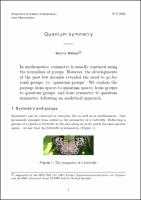| dc.contributor.author | Weber, Moritz | |
| dc.contributor.editor | Jahns, Sophia | |
| dc.contributor.editor | Skuppin, Lara | |
| dc.date.accessioned | 2020-06-04T11:55:10Z | |
| dc.date.available | 2020-06-04T11:55:10Z | |
| dc.date.issued | 2020-06-04 | |
| dc.identifier.uri | http://publications.mfo.de/handle/mfo/3747 | |
| dc.description.abstract | In mathematics, symmetry is usually captured using
the formalism of groups. However, the developments
of the past few decades revealed the need to go beyond
groups: to “quantum groups”. We explain the
passage from spaces to quantum spaces, from groups
to quantum groups, and from symmetry to quantum
symmetry, following an analytical approach. | en_US |
| dc.language.iso | en | en_US |
| dc.publisher | Mathematisches Forschungsinstitut Oberwolfach | en_US |
| dc.relation.ispartofseries | Snapshots of modern mathematics from Oberwolfach;2020,05 | |
| dc.rights | Attribution-ShareAlike 4.0 International | * |
| dc.rights.uri | http://creativecommons.org/licenses/by-sa/4.0/ | * |
| dc.title | Quantum symmetry | en_US |
| dc.type | Article | en_US |
| dc.identifier.doi | 10.14760/SNAP-2020-005-EN | |
| local.series.id | SNAP-2020-005-EN | en_US |
| local.subject.snapshot | Algebra and Number Theory | en_US |
| local.subject.snapshot | Analysis | en_US |
| dc.identifier.urn | urn:nbn:de:101:1-2020061509104318016495 | |
| dc.identifier.ppn | 170214674X | |


